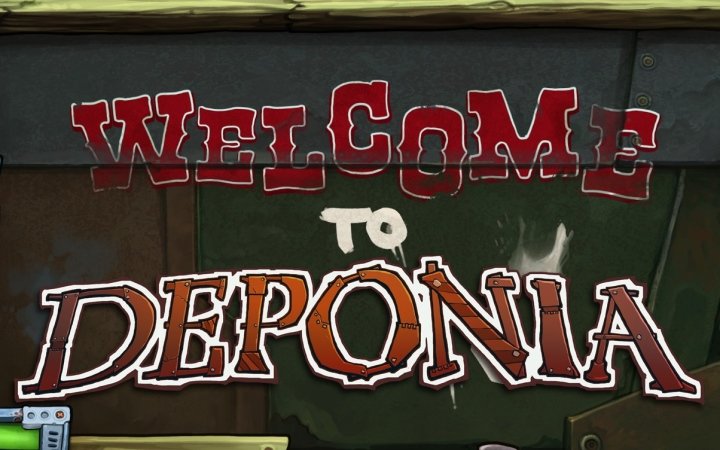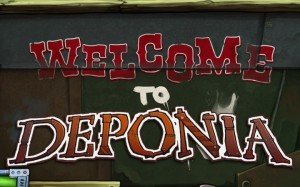
The game-smiths at Daedalic Entertainment are back again with another beautiful adventure to point, click, and combine your way through, this time set on the colorfully brown world described in the title, Deponia. Well known for their previously acclaimed adventure games The Whispered World and The Dark Eye: Chains of Satinav, Deponia represents another notch on their belts with a 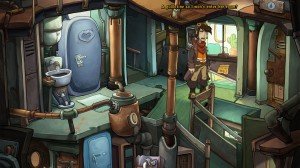 fun adventure that is fresh yet familiar to those following the company’s work. But is Deponia a triumphant, creative step forward, or does it firmly stay in the Daedalic comfort zone too much? Would you accept yes to both as an answer?
fun adventure that is fresh yet familiar to those following the company’s work. But is Deponia a triumphant, creative step forward, or does it firmly stay in the Daedalic comfort zone too much? Would you accept yes to both as an answer?
Deponia tells the story of Rufus, an egomaniacal manchild mooching off of his ex-girlfriend on a dump of a planet. It’s not just that Deponia is a bad place to live; it literally is a trash heap, full of broken steampunk gizmos and used bits of garbage. The residents of Deponia all know of a promised land in the sky called Elysium, but the fascist organization known as the Organnon control the only bridge between this advanced paradise and the broken surface. Rufus is the one resident who fully believes he deserves to move out of squalor and into Elysium. Therefore, he will stop at nothing to get there, developing dozens of insane plans that have ended just as badly as your average Road Runner cartoon. Players enter the game shortly before the trial run of the latest plan to reach his goal, but things go wrong quickly, and Rufus soon finds himself caring for an unconscious Elysian woman named, rather ironically, Goal. It’s a fairly entertaining story, though unfortunately, it does stay just a little bit too close to the major story elements of Chains of Satinav, and the many plot threads are hampered by a sudden ending that very obviously sets up a sequel. But that can be overlooked through consistently strong writing that, more than any other Daedalic release, has a fine sense of humor about it.
An adventure game can live and die on the quality of its writing, particularly when it comes to comedy. Thankfully, most of the comedy in Deponia hits the mark with a wide range of humor that veers from the usual endearingly lame adventure game observations to hilarious punchlines that catch you off guard. Particularly praiseworthy is the good use of swearing, which is thrown in sparingly and to great effect. The overall tone is a fairly clever 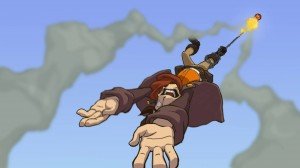 game that never steers into self-aware, reference-based parody territory, but instead sticks to wry jokes and original humor. Most of this comes from the fact that Rufus is a terrible human being. He’s rude, lazy, oblivious, and overwhelmingly self-centered. Usually, an unlikable main character would be the downfall of an adventure game, but Deponia keeps things grounded by making Rufus the butt of the joke more often than not. He fully believes that he is above everyone around him, but the game repeatedly counters this notion to make him the fool. Helping Rufus fail is often just as entertaining as watching him succeed; normally, an adventure game that continuously snatches the prize away just as you grasp it would get fairly frustrating, but Rufus is a character that needs to go through serious growth before the game ends. Sure, on the surface the game revolves around trying to return Goal to Elysium, but it’s also fun to watch Rufus grow from unlikable buffoon to fully realized character.
game that never steers into self-aware, reference-based parody territory, but instead sticks to wry jokes and original humor. Most of this comes from the fact that Rufus is a terrible human being. He’s rude, lazy, oblivious, and overwhelmingly self-centered. Usually, an unlikable main character would be the downfall of an adventure game, but Deponia keeps things grounded by making Rufus the butt of the joke more often than not. He fully believes that he is above everyone around him, but the game repeatedly counters this notion to make him the fool. Helping Rufus fail is often just as entertaining as watching him succeed; normally, an adventure game that continuously snatches the prize away just as you grasp it would get fairly frustrating, but Rufus is a character that needs to go through serious growth before the game ends. Sure, on the surface the game revolves around trying to return Goal to Elysium, but it’s also fun to watch Rufus grow from unlikable buffoon to fully realized character.
But the fact that Rufus is an unlikable buffoon does not mean he isn’t entertaining to watch. One of the absolute best aspects of the game is Rufus’ facial animations, which are simply a delight. It seems weird to focus on such a specific part of a game, but Rufus’ face is that incredible. His smiles, his frowns, his look of horror as he falls into a pile of cacti: all comic gold. Of course, this is all made possible by the game’s excellent cartoon art style. The Whispered World and Chains of Satinav looked like paintings, and to great effect, but Deponia exchanges this for a bright and bold style of animation that combines comics with Saturday morning cartoons and looks just as impressive. A side effect of the bright cartoon style is that the animations are far more dynamic and unique, ditching the somewhat stilted animation in Chains of Satinav for action-packed cut scenes and varied reactions to the world. It may not look like a painting, but the world is just as detailed and even more alive.
So the story and graphics are great, but how about the puzzles? Well, they aren’t bad, but they definitely aren’t the best out there. While the game does a great 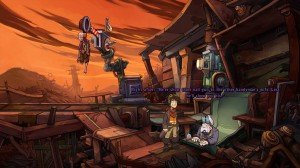 job of pointing out obvious elements to interact with and the frequent minigame-like brainteasers are good fun, the environmental interactions are often brought down by inventory bloat. Some segments shove around 25 items into your inventory at once, which isn’t terribly conducive to the age-old strategy of using everything on everything when you’re stuck. Thankfully, there aren’t any outstandingly unintuitive puzzles that compare to some of gaming history’s most infamous examples, and most of the solutions make a certain amount of sense, but a thorough understanding of point-and-click quirks is definitely required to beat the game without peeking at a walkthrough.
job of pointing out obvious elements to interact with and the frequent minigame-like brainteasers are good fun, the environmental interactions are often brought down by inventory bloat. Some segments shove around 25 items into your inventory at once, which isn’t terribly conducive to the age-old strategy of using everything on everything when you’re stuck. Thankfully, there aren’t any outstandingly unintuitive puzzles that compare to some of gaming history’s most infamous examples, and most of the solutions make a certain amount of sense, but a thorough understanding of point-and-click quirks is definitely required to beat the game without peeking at a walkthrough.
Final Verdict: If you’ve enjoyed previous adventures from Daedalic, Deponia is a fresh look for the familiar gameplay style. It won’t convert anyone on the fence with its slightly obtuse puzzles, but any adventure game fan will really enjoy the wonderful art and good writing.
Rating: 









This review is based on a review copy of the Steam PC version of Deponia provided by Daedalic Entertainment.

